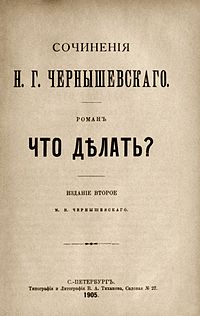What Is to Be Done? (novel)
 1905 title page | |
| Author | Nikolai Chernyshevsky |
|---|---|
| Original title | Shto delat (Что делать) |
| Language | Russian |
| Genre | Novel |
Publication date | 1863 |
| Publication place | Russian Empire |
Published in English | 1886 |
| Media type | Print (Hardback & Paperback) |
| ISBN | NA Parameter error in {{ISBNT}}: invalid character |
What Is to Be Done? (Russian: Что делать?, romanized: Shto delat'?; also translated as "What Shall We Do?") is a novel written by the Russian philosopher, journalist and literary critic Nikolai Chernyshevsky. It was written in response to Fathers and Sons by Ivan Turgenev. The chief character is a woman, Vera Pavlovna, who escapes the control of her family and an arranged marriage to seek economic independence. The novel advocates the creation of small socialist cooperatives based on the Russian peasant commune, but oriented toward industrial production. The author promoted the idea that the intellectual's duty was to educate and lead the laboring masses in Russia along a path to socialism that bypassed capitalism. One of the characters in the novel, Rakhmetov, became an emblem of the philosophical materialism and nobility of Russian radicalism. The novel also expresses, in one character's dream, a society gaining "eternal joy" of an earthly kind. The novel has been called "a handbook of radicalism"[1] and led to the founding of a Land and Liberty society.[2]
When he wrote the novel, the author was himself imprisoned in the Peter and Paul fortress of St. Petersburg, and he was to spend years in Siberia; the book was smuggled out from his cell. Lenin, Plekhanov, Peter Kropotkin, Alexandra Kollontay, Rosa Luxemburg, and also the Swedish writer August Strindberg,[3] were all highly impressed with the book, and it came to be officially regarded a Russian classic in the Soviet period.[4][5]
Plot introduction
Within the framework of a story of a privileged couple who decide to work for the revolution, and ruthlessly subordinate everything in their lives to the cause, the work furnished a blueprint for the asceticism and dedication unto death which became an ideal of the early socialist underground of the Russian Empire.
Reactions
The book is perhaps better known in the English-speaking world for the responses it created than as a novel in its own right. Fyodor Dostoevsky mocked the utilitarianism and utopianism of the novel in his 1864 novella Notes from Underground, as well as in his 1872 novel Devils. Leo Tolstoy wrote a different What Is to Be Done?, published in 1886, based on his own ideas of moral responsibility.[6] Vladimir Lenin, however, found it inspiring and named a 1902 pamphlet "What Is to Be Done?". Lenin is said to have read the book five times in one summer, and according to Professor Emeritus of Slavic and Comparative Literature at Stanford, Joseph Frank, 'Chernyshevsky's novel, far more than Marx's Capital, supplied the emotional dynamic that eventually went to make the Russian Revolution.' [7]
The main character of Gide's Les caves du Vatican (En. Lafcadio's Adventures), Lafcadio, bears a striking resemblance to Rakhmetov.
American playwright Tony Kushner referenced the book multiple times in his play Slavs!.
Footnotes
- ^ Middlebury College
- ^ Emory. It inspired several generations of revolutionaries in Russia: populists, nihilists, terrorists, and Marxists.
- ^ Jan Myrdal, Ord & avsikt
- ^ Чернец, Л.В. (1990). "Н. Г.: Биобиблиографическая справка". Русские писатели. Биобиблиографический словарь. Том 2. М--Я. Под редакцией П. А. Николаева. М., "Просвещение". Retrieved 2012-03-01.
- ^ Плеханов, Г.В. (1910). "Н.Г.Чернышевский". Библиотека научного социализма. Т.4. Retrieved 2012-03-01.
- ^ Boston theological
- ^ Amis, Martin (2002). Koba the Dread. Miramax. p. 27. ISBN 0-7868-6876-7.
References
- The Norton Anthology of World Masterpieces page 1085-1086
